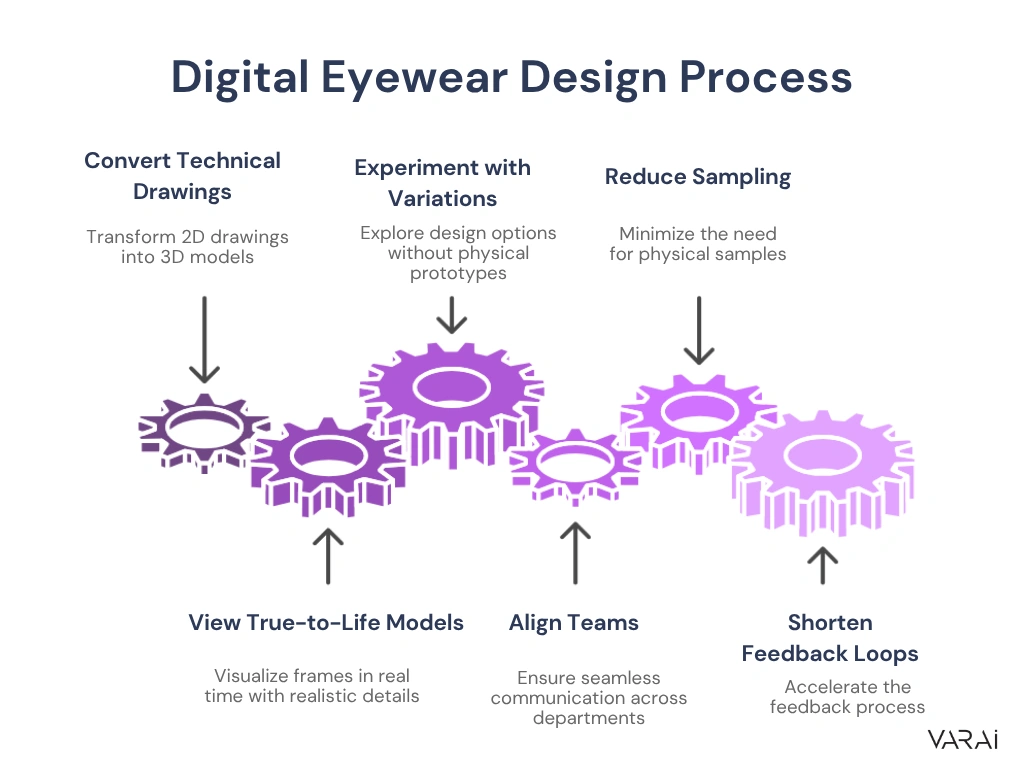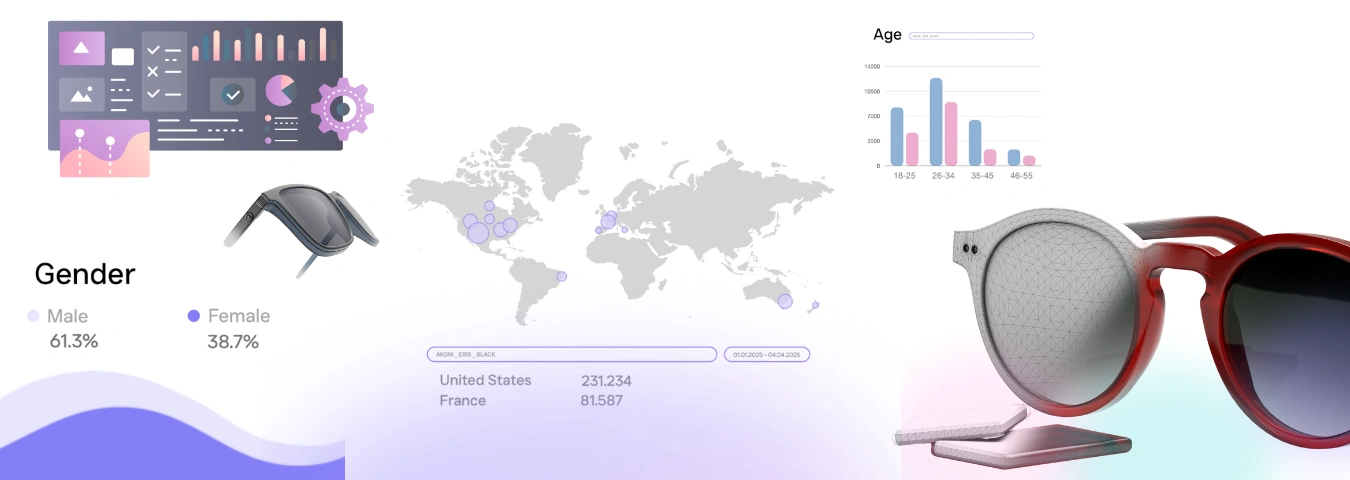Fast fashion cycles, shifting style trends, and rising consumer expectations have made it harder than ever for eyewear brands to keep up. Designing what customers actually want now requires precision, speed, and insight.
That’s where data-backed design comes in. Instead of guessing which frames will sell, brands can now use real-world data to guide decisions, reduce waste, and boost conversions.
VARAi’s Marketing Studio is a suite of powerful tools that helps brands move from CAD to 3D, analyze face shapes, run virtual try-ons, and predict top-performing designs using AI.
In this blog, we’ll explore why investing in data-backed tools isn’t optional anymore and how brands using them are designing smarter and selling faster.
The Problem with Guesswork in Eyewear Design
Traditional eyewear design is a long, analog process, often taking 6 to 9 months from sketch to sample. Designers rely on instinct, flat sketches, and back-and-forth with manufacturers, leading to costly delays and mismatched market fit.
Here’s where the real problems show up:
- Subjective decision-making: Designs are typically based on what creators love, not what data says customers want.
- Physical prototyping cycles: Each revision adds time, money, and waste.
- Lack of visual clarity: Stakeholders struggle to picture the final product from 2D files.
- Poor manufacturer communication: Errors in translation from design to production are common.
As a result, brands may launch frames that underperform or miss the trend window entirely. Another problem is the lack of data that shows what frames, designs, materials, or shapes are performing well and which ones aren’t. This data is extremely important and helps brands make crucial investment decisions. Only data-driven designs can cut costs of things like materials that account for at least 20% to 40%.
Data-Driven Design Is the Smart Approach
Designing without data is like making a rushed decision for your business that goes wrong. In a fast-moving market, creativity and instinct have no place. Especially, when at the end of your value chain is a customer whose tastes will differ based on their opinions.
Data-backed design replaces trial-and-error with clarity. Specific data points, such as face shape, eye color, age, dimensions, and selection of frames, are stored. This reveals what styles are trending, what frame fits customers best, and which designs drive engagement and sales.
The impact? Smarter decisions, faster product cycles, and fewer costly revisions.
When every design choice is grounded in insight from fit data to trend signals, you will create products that will sell and earn you (brands, manufacturers, optical stores, online stores) profits.
Iterate Designs Faster with CAD to 3D Visualization
Eyewear design processes are trying to be faster. It is being achieved through technology (3D printing for eyewear frames), but it is also being done through digital prototyping (2D to 3D model conversions). This digitization of eyewear helps with countless revisions and physical samples by limiting it to a digital file rather than adding cost and complexity physically.

By converting technical drawings into high-fidelity 3D eyewear models, you eliminate guesswork and accelerate timelines from the start. You can:
- View true-to-life frame styles, colors, and materials in real time
- Experiment with design variations without the need for prototypes
- Instantly align teams across design, marketing, and manufacturing
- Reduce unnecessary sampling, save on costs, and shorten feedback loops
Also, photorealistic textures, reflections, and finishes help you visualize the 3D models from the initial stage to the finished state. Every detail and change can be monitored or made before production even begins. You get a clear, precise look at what you’re creating, no more waiting weeks for a physical sample.
Understand What Your Customers Actually Want
Designing for everyone often means designing for no one, especially in eyewear. The preferences of your end customer can be too varied based on age, gender, face shape, and lifestyle. Instead of releasing safe, previously trendy eyewear frames, you can use real-world data from tools like VARAi’s Marketing Studio and start testing your customer base.
If you also want to make data-driven decisions, here is how you can do that:
- According to CDC data, about 25% of children aged 2–17 wear corrective lenses, and usage increases with age, highlighting how different demographics require targeted design, only possible with a versatile software.
- Face Shape Analyzer maps customer facial features to pinpoint frames that flatter specific profiles.
- AI Eyewear Recommender captures real behavior, try-on, and purchase patterns to identify top-performing styles and variants.
Combining demographic insights with fit and trend data empowers brands to design collections that align with actual needs.
Predict Market Trends Before They Happen
Once you understand your customers’ preferences, the next step is staying ahead of what they’ll want next. Eyewear trends can shift quickly; what worked last season may not resonate today. A quick look at a market trend:
“Data shows a growing shift toward geometric and transparent frames among Gen Z, while professionals aged 35–50 are leaning into titanium minimalism and blue-light lenses.”
Rather than choosing one style over another, or even designing an eyewear frame that is a mix of both, it is better to use predictive insights.
By analyzing engagement data from VARAi’s tools, such as Virtual Try On and AI Eyewear Recommender, brands can spot rising trends in frame shapes, colors, and lens finishes across specific demographics.
This lets you avoid overproducing or over-manufacturing units of the same eyewear design that has become outdated. Also, this market trend and the data you gather will help you catch micro-trends without redoing your entire collection.
Enhance Customer Experience Through Virtual Try-On Feedback
Making customer-centric frames is just not enough. To make sure they actually buy the product, companies use tools like Virtual Try-On (VTO). VTO has a lot of uses other than just placing the 3D model of eyewear on the customer’s face. It also tracks behavioral data. Every try-on session reveals what catches attention but doesn’t convert, helping brands understand silent friction points in shape, size, color, or style. Here’s how the feedback loop works:
Try-on → No purchase → Data captured → Behavior analyzed → Insights applied to design or messaging → Improved next-gen try-ons
This loop runs silently in the background, offering powerful, real-time feedback without needing customer surveys. When integrated with your design workflow, it refines your collection and sharpens marketing efforts. If you follow the entire loop closely, it can make each frame smarter, not just prettier. With tools like VTO, your eyewear brand evolves with every click, swipe, and skip.
Data-Backed Design Drives More Confident Investment
Launching a new eyewear line is capital-intensive, and some brands can’t afford costly mistakes. This is the reason data-tracking tools are becoming increasingly common in verticals like eyewear. Each frame SKU requires commitment across production, inventory, and marketing, which helps support it. Without the right insights, these investments can quickly become sunk costs.
Here’s how data-backed design helps mitigate that risk:
- Virtual try-on data reveals which styles drive engagement and conversion.
- Trend forecasting highlights designs aligned with current demand.
- Behavioral analytics identifies top-performing SKUs early.
With these tools, brands move from instinct to strategy. And that level of clarity builds stakeholder trust and opens doors to retail and investor partnerships.
Conclusion
Design decisions rooted in data lead to better outcomes every time. Eyewear is all about speed, accuracy, and adaptability, especially pertaining to the designing process. Data-backed design isn’t just a smarter way to create; it’s the only way to stay competitive.
From trend prediction to fit optimization, each insight reduces waste and sharpens your strategy. The brands embracing this shift aren’t just designing better frames; they’re building scalable, future-ready businesses shaped by real-world behavior and measurable results.
Meet the Marketing Studio, Your Data-Powered Eyewear By VARAi
VARAi makes eyewear fresh, trendy, and data-backed. VARAi’s Marketing Studio was built to give eyewear brands the precision tools they need to design, test, and sell smarter.
This all-in-one platform brings together four essential technologies:
- CAD to 3D Modeling: Instantly convert technical drawings into lifelike 3D frames. See materials, finishes, and proportions before a single sample is made.
- Face Shape Analyzer: Map facial structures to identify which styles and dimensions flatter real customers, no generic recommendations here.
- AI Eyewear Recommender: Learn from actual try-on behavior to surface bestsellers, identify drop-off points, and refine product-market fit.
- Virtual Try-On (VTO): Deliver a straightforward, interactive customer experience while collecting conversion-driving data in the background.
Together, these tools form a closed-loop system, where insights from one tool refine decisions in another.

